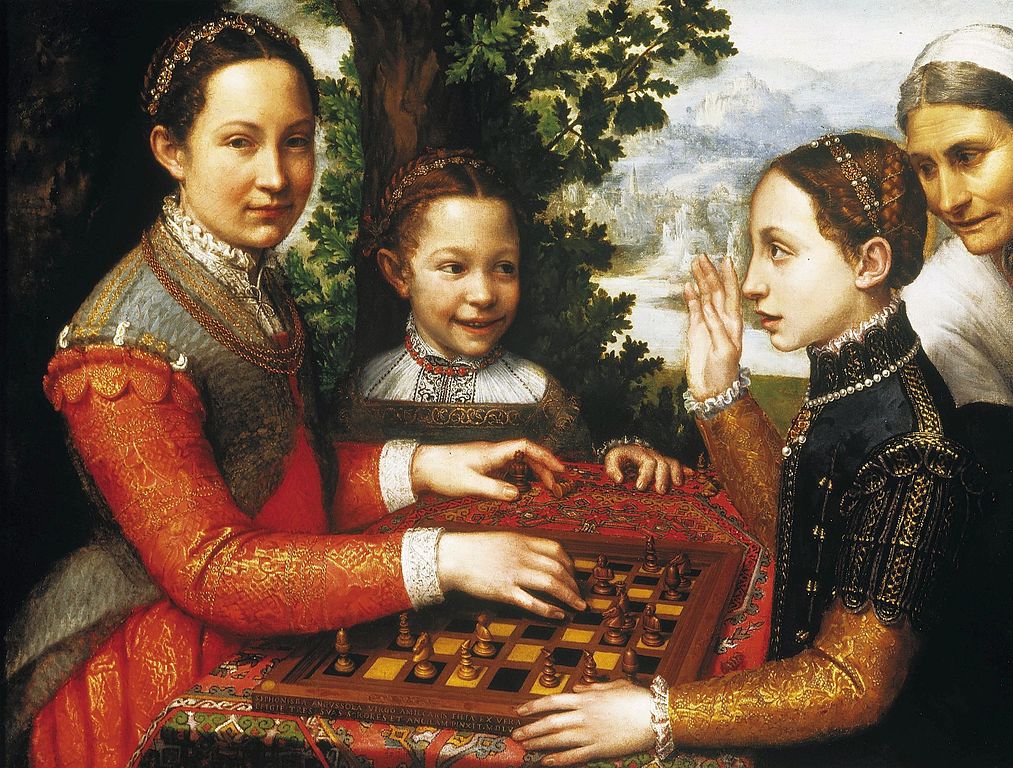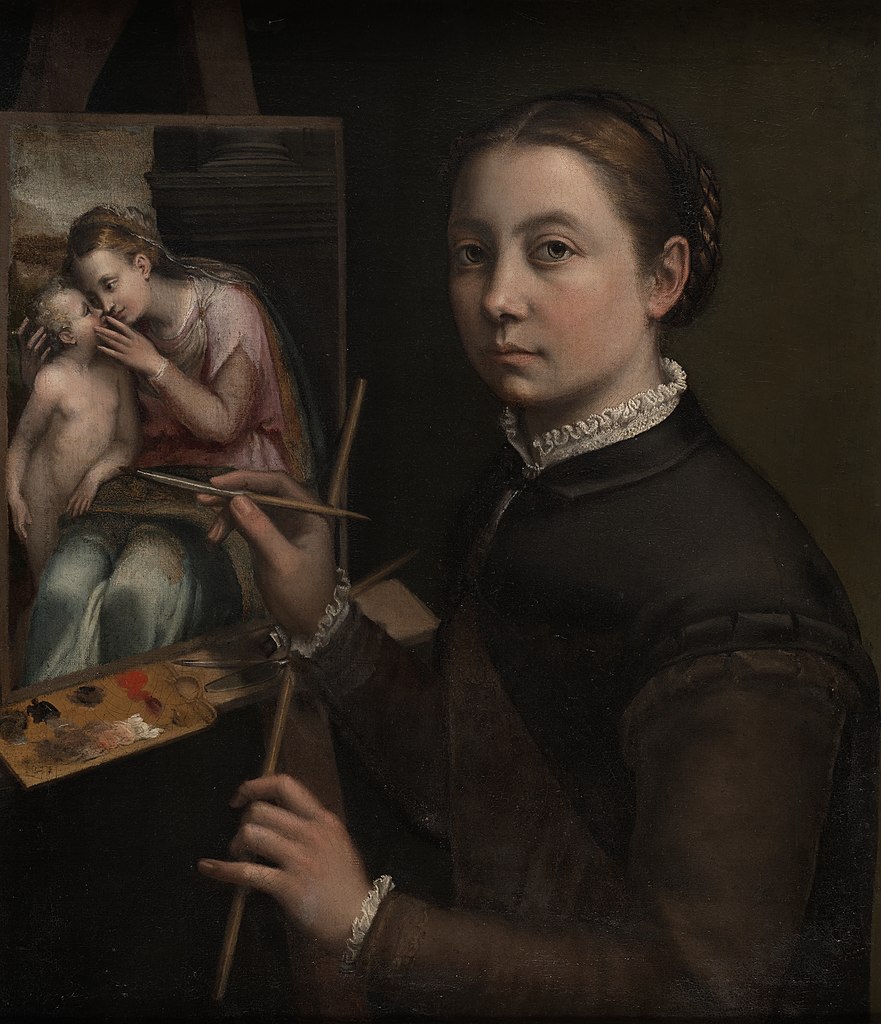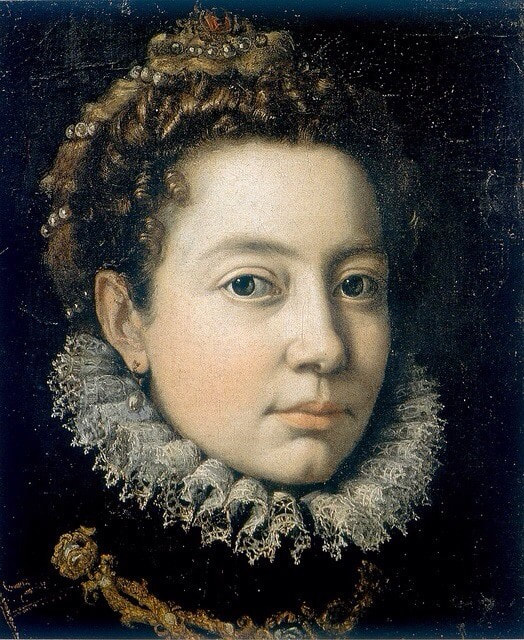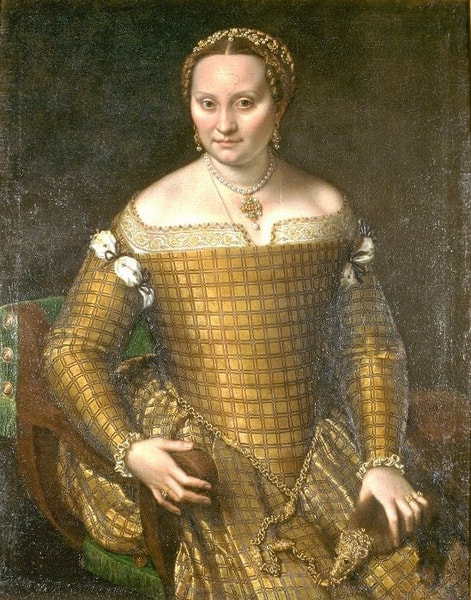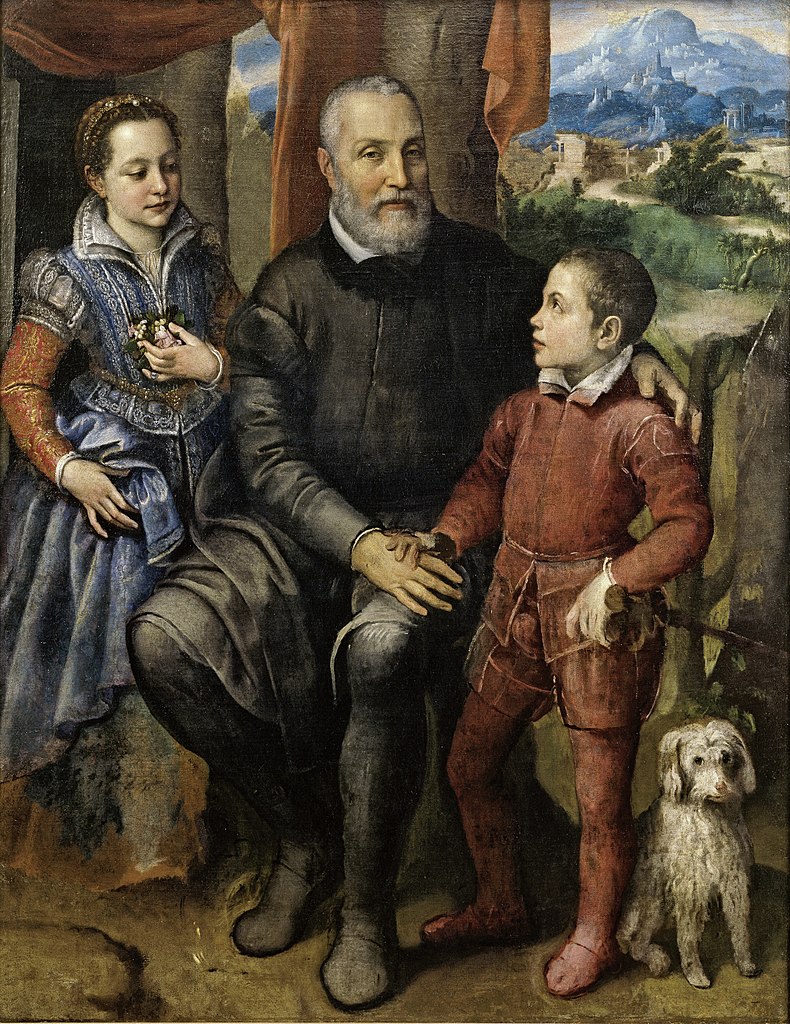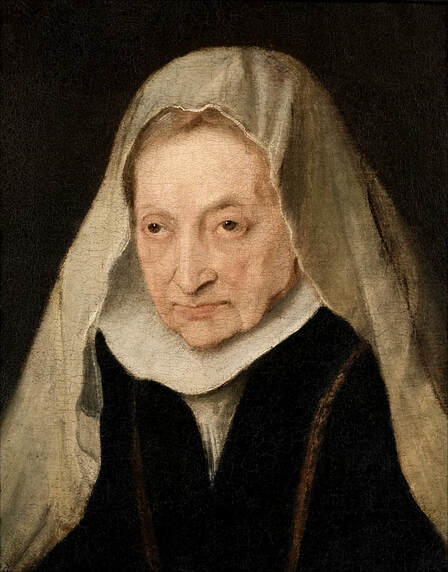|
Where? National Museum in Poznań
When? c. 1555 What do you see? Three of Sofonisba Anguissola’s younger sisters at a table in a grand setting, playing a chess game. They are observed by the family housemaid on the top right. It not only provides a glance at some of Sofonisba’s younger sisters who also studied painting at that time, but also showcases the sophistication of the Anguissola family, an aspect that is further emphasized by their luxurious clothing and jewelry. The painting shows how the oldest of the three portrayed sisters, Lucia, has made the decisive move to win the game. We can see how she holds the black queen in her left hand, indicating that she has defeated her sister. Her younger sister Europa, on the right, has to concede and shows her admiration by looking at her older sister. The youngest of the three, Minerva, grins at Europa to see her reaction. The Chess Game is a lively scene expressing the interactions between the sisters through their facial expressions, and the oldest sister engages the viewer by directly looking at us, as if asking for some praise for her achievement. And the nurse is still contemplating the sequence of moves that had led to the victory.
Backstory: The parents of Sofonisba Anguissola highly valued intelligence and education, and provided equal opportunities to their daughters and son, something that was quite unique in Renaissance Italy. That the girls played chess is evidence of their sophistication. Chess was already considered a highly intelligent activity during the Renaissance, but it was mainly played by men at that time.
Giorgio Vasari who had seen this painting in the house of Sofonisba’s father in 1566 commented that the work combined diligence, which we can see in the imaginary sfumato background typical for Renaissance art, and quickness, which makes the characters come alive. The only thing lacking according to Vasari was that we cannot hear the protagonists speak. Who is Anguissola? Sofonisba Anguissola (1532-1625) was born in Cremona, about 80 km southeast of Milan as the oldest child of Amilcare Anguissola and Bianca Ponzone, who belonged to the minor nobility. Inspired by Baldassare Castiglione’s advice on the education of women in his Il Cortegiano of 1528, her parents ensured that Sofonisba, her brother, and five sisters all received a solid education and had the opportunity to further develop their talents. While one of her sisters, Minerva, and her brother Asdrubale pursued other artistic interests, Sofonisba and her four other sisters studied painting. In 1558, her reputation had risen to the level that the influential art patron the Duke of Alba recommended her to the Spanish king, Philip II. He invited her to Madrid to become the lady-in-waiting to his wife, Queen Elisabeth of Valois. She would stay in Madrid for 14 years and would paint numerous portraits for the Spanish court. At age 39, she would marry to a nobleman from Sicily, and they would move back to Italy. She never had children and enjoyed a long and prosperous career. Among her paintings are two well-known self-portraits, one showing her at the easel at age 24 and another one painted at age 32.
The Anguissola sisters: Today, Sofonisba is the best-known artist of the Anguissola sisters. Her parents stimulated her education, and she painted her family several times. She trained some of her younger sisters as painters. Her sister Elena gave up her art ambitions when she became a nun, and Anna Maria and Europa dedicated themselves to their family after their marriage. In contrast, Lucia, shown on the left of the painting, followed in Sofonisba’s footsteps as a professional artist. Some contemporaries have even mentioned that she had more talent than Sofonisba, but as she would prematurely die in her late twenties that potential was never fully realized.
Fun fact: As a teenager, Sofonisba was apprenticed to two local painters, something that was very uncommon for girls at that time. When Sofonisba completed her training, she started her career as a professional artist, though she did not stop learning. During her early twenties, she regularly traveled within Italy and build up a good network including some influential art patrons and artists. And her father continued to support her, as evidenced by a letter he sent in 1557 to Michelangelo, thanking him for the lessons he had provided to his daughter.
Sofonisba was well-connected in the art world and frequently received visitors in Palermo and she was happy to share her artistic expertise with them. Among her many visitors was the Flemish master Anthony van Dyck, who even painted a portrait of her at age 92. She did not only directly inspire other artists during her lifetime, she has especially inspired many female artists over the next centuries. The fact that she had a successful international career and her life story is relatively well documented, has allowed aspiring female artists and their families to use her life story as an example of how a woman could craft a successful career as an artist.
Written by Eelco Kappe
References
1 Comment
8/27/2022 04:39:05 am
Great article! Thanks for sharing this amazing article with us. I really like this article and found very informative and helpful for me.
Reply
Leave a Reply. |
Categories
All
|
- Home
- Blog
-
Museums
- Alte Pinakothek
- Art Institute of Chicago
- Baltimore Museum of Art
- Barber Institute of Fine Arts
- Bargello
- Barnes Foundation
- British Museum
- Church of Sant’Anastasia
- Cleveland Museum of Art
- Courtauld Institute of Art
- Detroit Institute of Arts
- Frans Hals Museum
- Galleria Borghese
- Gallerie dell'Accademia
- Getty Museum
- Guggenheim
- Hermitage Museum
- Kunsthistorisches Museum
- Kunstmuseum Basel
- Legion of Honor Museum
- Louvre
- Mauritshuis
- Metropolitan Museum of Art
- Musee d’Orsay
- Museum of Fine Arts in Boston
- Museum of Modern Art
- National Gallery in London
- National Gallery of Art
- National Museum in Poznań
- Norton Simon Museum
- Ny Carlsberg Glyptotek
- Palace of Versailles
- Palazzo Pitti
- Palazzo Vecchio
- Petit Palais
- Philadelphia Museum of Art
- Prado
- Pushkin Museum
- Ravenna Art Museum
- Rijksmuseum
- San Diego Museum of Art
- Santa Maria delle Grazie
- St. Peter's Basilica
- Städel Museum
- Statens Museum for Kunst
- Tate Britain
- Tate Modern
- Timken Museum of Art
- Uffizi
- Vatican Museums
- Wallace Collection
-
Artists
- Altdorfer
- Anguissola
- Berlin Painter
- Bosch
- Botticelli
- Boucher
- Bronzino
- Bruegel the Elder
- Brunelleschi
- Cabanel
- Caillebotte
- Canova
- Caravaggio
- Carpeaux
- Cezanne
- Cimabue
- David
- Degas
- Delacroix
- De Maria
- Donatello
- El Greco
- Fontana
- Fra Angelico
- Fragonard
- Gauguin
- Gentileschi
- Gericault
- Gonzalez-Torres
- Goya
- Hals
- Hogarth
- Hokusai
- Ingres
- Leonardo da Vinci
- Lippi, Filippo
- Longhi, Barbara
- Lorrain
- Makovsky
- Manet
- Massys
- Matisse
- Merian
- Michelangelo
- Mochi
- Modigliani
- Monet
- Panini
- Parmigianino
- Perugino
- Picasso
- Pisanello
- Raphael
- Rembrandt
- Renoir
- Reynolds
- Rivera
- Rodin
- Rubens
- Scultori
- Seurat
- Steen
- Tintoretto
- Titian
- Toulouse-Lautrec
- Turner
- Uccello
- Van der Weyden
- Van Dyck
- Van Eyck
- Van Gogh
- Van Hemessen
- Vasari
- Velazquez
- Vermeer
- Veronese
- Vigée Le Brun
-
Locations
- Books
- About Us

